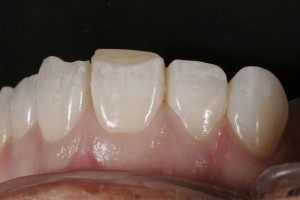Ceramic Porcelain Fracture Guidelines #1: Setting Up The Occlusion
When a patient presents with a ceramic porcelain fracture, dentists can become (reasonably) wary of this restoration nightmare. This problem is one of the most disheartening that can happen in a dental office and because of this, many doctors will become so fearful of the fracture that they will avoid placing ceramic restorations at all.
For the first post in this series, I discussed three reasons why dentists back away from ceramic restorations. I also brought up what questions to consider when recommending parafunctional control appliance to your patient.
In this post, I’ll introduce you to my first guideline for placing ceramic restorations.
Occlusion’s Role in Ceramic Porcelain Fracture
Clinical Approach: Set the occlusion up as a parafunctional appliance that cannot be removed.
Let’s back up a second to explain the reasoning behind the above clinical approach. One way that ceramic porcelain fracture can occur is when a patient grinds their teeth (excursive movements=shearing forces) and creates potentially harmful force on anterior all-ceramic restorations.
At the the root of the problem (excursive movements) is a misconception about how occlusion fits into the picture and a lack of understanding that posterior teeth contact leads to an increase in elevator muscle force.
 Clenching and grinding teeth during sleep, often termed “bruxism,” occurs independently of the type of occlusion present. What this means is that even if you change the occlusion, bruxism may still occur.
Clenching and grinding teeth during sleep, often termed “bruxism,” occurs independently of the type of occlusion present. What this means is that even if you change the occlusion, bruxism may still occur.
Here’s how you can solve this problem:
- Deprogram hyperactive muscles
- Remove posterior interferences into closure
- Set up cosmetic cases with anterior guidance (immediate lateral and protrusive guidance)
These three steps will prevent posterior teeth from coming into contact in excursive movements. This results in reduced muscle contraction force.
Keep in mind that this occlusion won’t completely eliminate your parafunction problem. What it will do is prevent this one potential cause of fracture by reducing occlusal breakdown present prior to the restorations being placed.
Your Chief Protocol in Porcelain Protection
You must test this new planned occlusion in temporaries, especially because the occlusion alters and reduces forces rather than completely stopping parafunction.
This will enable you to determine whether it is the right method for a patient’s particular treatment plan.
Even perfect occlusion cannot always prevent porcelain fracture. This approach will most likely work better with patients who have orofacial pain and can see direct benefits from compliance with protective appliances.
Bonus Tip: Knowing the forces present on restorations and the timing of occlusion is superior to the use of articulating paper alone.
Look for the next five guidelines in the series to learn how to limit the percentage of porcelain fracture in your office. These tips are a compilation of ceramic restoration knowledge that I have put together over 10 years of performing “cosmetic rehabilitations.”
 Read Dr. Nosti’s introductory post to ceramic porcelain fracture and check out his other treatment planning post on shrink wrap provisionals.
Read Dr. Nosti’s introductory post to ceramic porcelain fracture and check out his other treatment planning post on shrink wrap provisionals.




